
Related
Guests
- Maya Odeigraduating senior majoring in bioengineering and a member Who’s Teaching You?, a Stanford student organization seeking faculty diversity and support for marginalized studies and community centers.
- Judge LaDoris Cordellretired superior court judge who spent 19 years on the bench in Santa Clara County in California. She is former assistant dean at Stanford Law School and former vice provost of Stanford University.
Stanford University students are demanding change in faculty diversity. Stanford’s faculty is 73 percent white and 73 percent male, while less than half the undergraduate student body is white. The student diversity effort, called Who’s Teaching Us?, grew out of Stanford’s Asian American Activism Committee in 2014 when the Stanford English Department denied tenure to a queer Asian-American scholar, a trusted mentor among the student community. The movement has since expanded to include all students of color and marginalized identities. Who’s Teaching Us? recently issued a list of 25 demands to the administration, including increased diversity among faculty and the curriculum, residential space and other programs that meet the needs of students of color, and divestment from institutions that harm marginalized communities. We speak to Stanford student Maya Odei and LaDoris Cordell, a retired superior court judge who spent 19 years on the bench in Santa Clara County in California. She is former assistant dean at Stanford Law School and former vice provost of Stanford University.
Transcript
AMY GOODMAN: This is Democracy Now!, democracynow.org, The War and Peace Report. I’m Amy Goodman. We’re on our 100-city tour, and we end the show here on the campus of Stanford University, where students are demanding change in faculty diversity. Stanford’s faculty is 73 percent white and 73 percent male, while less than half the undergraduate student body is white. The student diversity effort called Who’s Teaching Us? grew out of Stanford’s Asian American Activism Committee in 2014 when the Stanford English Department denied tenure to a queer Asian-American scholar, a trusted mentor among the student community. The movement’s since expanded to include all students of color and marginalized identities.
Who’s Teaching Us? recently issued a list of 25 demands to the administration, including increased diversity among faculty and the curriculum, residential space and other programs that meet the needs of students of color, and divestment from institutions that harm marginalized communities. The group held a rally and forum where members of the administration were invited to address the demands. No one from the administration showed, but Stanford President John Hennessy did send a letter of response. This is student Lina Khoeur reading the letter from President Hennessy, followed by Phuntso Wangdra with the response from Who’s Teaching Us?
LINA KHOEUR: Many of the issues you have identified are complex in nature and must be addressed through detailed analysis and thoughtful discussion. As you know, we have agreed to proceed with a set of structured conversations around each of the six issue areas identified in your letter. … I believe this process will facilitate a useful and constructive dialogue leading to action. It [also will] reveal realistic timeframes for addressing the issues under discussion.
PHUNTSO WANGDRA: We have already done that detailed analysis. That’s the 25 demands that were given to you and repeatedly given to you. Even though it’s beyond our responsibility as students, we’re going to be holding you to this, to actually taking action from these dialogues that you want so much. This is not a new conversation, people. From the BSU demands of 1968 to the takeover of the President’s Office in 1989, students have been demanding the same things for decades. But where is this change? Why are we here? Time and time again, we see the administrators engage in dialogue but fail to take action. Right now, we demand action.
AMY GOODMAN: The efforts at Stanford University follow several other student actions on campuses across the country, including University of Missouri, Yale and Ithaca College. The president of Mizzou—that’s the University of Missouri—resigned after weeks of demonstrations by black students against what they called a lax response to bigotry and vandalism on campus.
Well, for more on diversity here at Stanford University, we’re joined by two guests. Maya Odei is a graduating senior majoring in bioengineering and a member Who’s Teaching You? And we’re joined by Judge LaDoris Cordell. She’s a retired superior court judge who spent 19 years on the bench in Santa Clara County in California. She’s former assistant dean at Stanford Law School and former vice provost here at Stanford University.
We welcome you both to Democracy Now!
LADORIS CORDELL: Thank you.
MAYA ODEI: Thank you.
AMY GOODMAN: But I want to begin with Maya. What is Who’s Teaching Us?
MAYA ODEI: Yeah, so Who’s Teaching Us? is a student coalition working to better our university. So, as you mentioned, we’re calling on the university to diversify its faculty, its student body, its curriculum. And we’re also asking for the university to divest from private prisons and in other ways to cease from harming black and brown bodies.
AMY GOODMAN: And what kind of response have you gotten?
MAYA ODEI: So, as you mentioned, we did not, unfortunately, see any of the administration at our event on April 8th, which we asked them to attend. Fortunately, we have seen some sort of response from them. So, you mentioned the letter from Hennessy. Additionally, we have set up committees, and we are, through those committees, engaging in dialogue with university administrators.
AMY GOODMAN: Now, we are joined, as I said, by Judge LaDoris Cordell. She is the retired assistant dean of Stanford Law School. She is also the first African-American woman judge in Northern California and former vice provost of Stanford University. I’m looking, Judge Cordell, at some old articles about you, and one of them is a picture of you bringing diversity to campus at Stanford University. What is it that you did, what you were called in to do? And then we’ll look at what’s happened since.
LADORIS CORDELL: Right. So we’re talking about 1978. And in 1978, I became the assistant dean of the law school. And I was primarily brought in to diversify the student population. There were very few people of color at the law school. The first African-American Stanford Law graduate was 1968, and the first Latino was 1969. So, I came in, and I was given license to create—
AMY GOODMAN: As a Stanford University—
LADORIS CORDELL: At the law school.
AMY GOODMAN: Right, but as a Stanford University law student, you were one of the very first black woman students.
LADORIS CORDELL: Early on, yes, early on. But there had been some before me. My job, though, as the assistant dean, was to bring in greater numbers, to bring in a critical mass of black and brown bodies into the law school. And I was able to do that by having a very aggressive recruiting process. And I was permitted to do that and to create it on my own. And after the first year, Stanford emerged as the first among major law schools to have such a large enrollment—22 percent of the entering class were black and brown bodies—and sustained that for the four years I was the assistant dean.
AMY GOODMAN: You did something unusual for Stanford: You actually started to recruit from historically black colleges?
LADORIS CORDELL: Absolutely. I got off the campus and went out and was at—a presence at campuses around the country, but for the first time was a presence at historically black colleges and universities.
AMY GOODMAN: Now, Who’s Teaching Us? raises the question of faculty diversity. What’s the faculty diversity at the Stanford Law School?
LADORIS CORDELL: Well, let’s go back just when I was a student, which was 1971 to '74. There were no professors of color at all in the law school. So, I was—ended up being the only black female in my class, sporting a big Afro and the whole bit. And I had no one to whom I could relate, in terms of looking like me. So, today, there is quite a bit of difference. There has been progress. But I will note that today, and this is from the entire history of Stanford Law School, there has never yet—there's yet to be a tenured black woman professor.
AMY GOODMAN: Why is this so important to you, Maya Odei?
MAYA ODEI: Yeah, so, as you mentioned, it’s very important to me to have professors who look like me and who I feel that I can relate to. So, especially being in a STEMM field, you don’t see too many—
AMY GOODMAN: Explain STEMM.
MAYA ODEI: Oh, yeah.
AMY GOODMAN: What does it stand for?
MAYA ODEI: So, especially being in science, technology, engineering, mathematics and medicine, you don’t see too many diverse faculty, which is very unfortunate for students who look like me.
AMY GOODMAN: And this issue of investment and divestment, explain the companies you want Stanford to stop investing in.
MAYA ODEI: So we want Stanford to stop investing in the private prison-industrial complex, including companies like Corrections Corporation of America, including GEO Group and other auxiliary companies who help them to remain so robust.
LADORIS CORDELL: I was telling Maya that when I was a student here, our protest was to divest—ask Stanford to divest from companies that engaged in business with South Africa. So, it’s so interesting how we’re still on the same arc.
AMY GOODMAN: So, we’re talking to you. You’re not a current administration official here at Stanford; you’re a past one. How difficult is—does a movement like Maya’s, Who’s Teaching Us?—that’s their organization—how did you find the administration responds when they get pressure from students?
LADORIS CORDELL: Yeah, well, first of all, it’s hard to do it as a student, because student body is transient. You’re going to be here for a few years, and then you’re out. And so, it’s really hard to keep momentum going on the student side. On the other, it’s really the more you have administrators and faculty who look like you, the more responsive or quickly responsive they will be to you. And I’ve found that, as a student, it’s the more pressure you can sustain on an administration, and that’s how you bring change. So, it’s not easy. And I say to you, Maya, hang in there, because the more you can sustain this and have others coming after you, then the more certain you are to bring change.
MAYA ODEI: Yeah, which is why we’re really attempting to build sustainability into our movement, so we not only have a large upperclassman representation, but also do very active recruitment for underclassmen, freshmen, sophomores.
AMY GOODMAN: And how large is Who’s Teaching Us?
MAYA ODEI: So, we’re a pretty large organization. I’m not sure of the exact number. And then, in addition to our core members, we have a lot of support from the student body at large.
AMY GOODMAN: Judge Cordell, I wanted to ask you about a slightly different issue.
LADORIS CORDELL: Sure.
AMY GOODMAN: The big front page—let’s see, we’re traveling on the road, and I’m taking a look at USA Today. It says, “Chicago Police Face Racism Charge.” It’s the big story across the whole front page. Talk about what you’re doing today, how you’re related to oversight around police actions.
LADORIS CORDELL: Right. So this report is not a surprise to me, and it shouldn’t be a surprise to those who—racism in policing in Chicago. It’s kind of—we know about it. But it’s a very in-depth report, and I encourage everyone to read it. So, for the last five years, I’ve been engaged in independent civilian oversight of the police. And this is really important, because what I did in working in this capacity was to bring transparency and accounting to policing, because there is no sunshine in policing. There is very little the public knows about how police departments operate and the rules that guide them. So, and my involvement was to basically provide oversight. If you had an issue with a police officer in San Jose, you could come to our office, bring a complaint, and then we had oversight over how that complaint was investigated by the department. Independent oversight is spreading throughout the country, and clearly it’s needed in Chicago, and it’s needed in New York, it’s needed everywhere. I’m not sure if that’s a recommendation—I’m willing to bet it is—in the task force report.
AMY GOODMAN: I think there are over—well over a hundred recommendations in this report. The first sentence of the USA Today piece: “The city’s police department”—talking about Chicago—”is beset by racism and needs sweeping reforms to help it win back [trust in] the community.”
LADORIS CORDELL: Right. And winning back trust all depends on accountability and transparency. Without it, there can be no trust.
AMY GOODMAN: Do you have any advice for Maya and for the students of Who’s Teaching Us?, as a former administrator at Stanford—
LADORIS CORDELL: Yeah.
AMY GOODMAN: —how best to force change here?
LADORIS CORDELL: Right. First is, don’t be discouraged. Change will come. But it will only become—come about—and it’s something about what Amy Goodman has been talking about for years, and it’s that movements matter, that a movement—and just in the word itself—means you’re making progress, you’re moving forward. Movements matter. And it is important that you all continue the message, sustain it. Do not get discouraged because you’re not seeing change right away. It will happen.
AMY GOODMAN: And, Maya Odei, what do you think is the most important thing for the administration here to respond to right now? Or is it just about, for you, student organizing?
MAYA ODEI: So, I think what’s most important is for the administration to truly show that they care about what we, the students, have to say—for example, by showing up to events like our April 8th event.
AMY GOODMAN: Which was?
MAYA ODEI: It was titled “Pack the NACC.” And at the event, we asked for the administration to come, to show their support and to sign on to our demands.
AMY GOODMAN: And did they?
MAYA ODEI: And they did not.
AMY GOODMAN: I want to thank you both for being with us. This is clearly a conversation that’s continuing here and at campuses across the country. We’ll be at a number of campuses on our 100-city tour. You can check our website at democracynow.org. Maya Odei, member of Who’s Teaching Us? at Stanford University, and Judge LaDoris Cordell, retired superior court judge, the first African-American woman judge in Northern California, assistant dean at the Stanford Law School formerly and former vice chancellor.
That does it for our broadcast. We’re on our 100-city tour. Today we’ll be at Pitzer College in Claremont, California at noon, and tonight in Los Angeles. Check our website. Tomorrow, we’ll be at Skylight Books in L.A. and Bookstar in Studio City at night; Saturday, Santa Rosa, Willits and Redway; and on Sunday in Davis, Chico and Berkeley. Then we’re on to Salt Lake City and Idaho Springs in Colorado and Denver and Boulder. Check, again, democracynow.org.

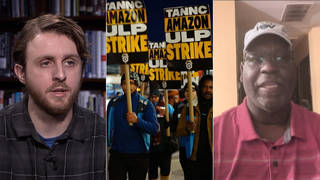

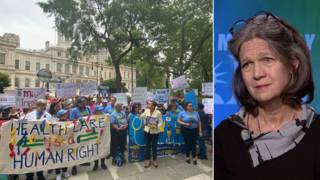




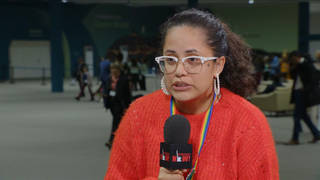

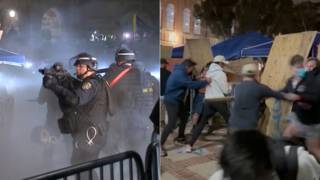
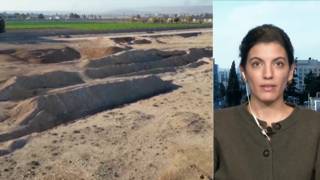
Media Options